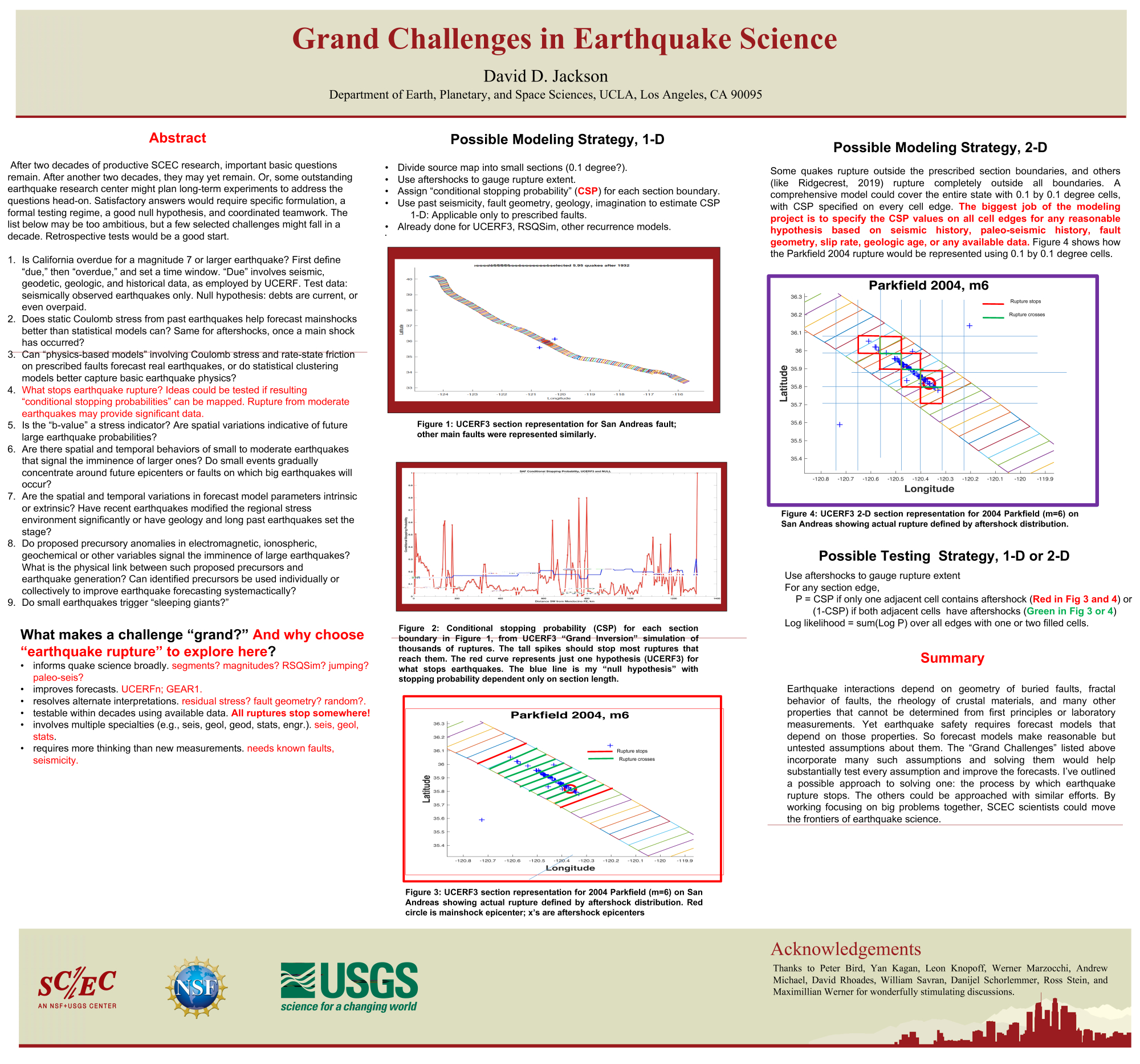Poster #085, Earthquake Forecasting and Predictability (EFP)
Grand challenges in earthquake science
Poster Image:

Poster Presentation
2020 SCEC Annual Meeting, Poster #085, SCEC Contribution #10723 VIEW PDF
, and historical data, as employed by UCERF. Test data: seismically observed earthquakes only. Null hypothesis: debts are current, or even overpaid. A retrospective test would be a good start.
2. Does static Coulomb stress from past earthquakes help forecast mainshocks better than statistical models? Same for aftershocks, once a main shock has occurred?
3. Can “physics-based models” involving Coulomb stress and rate-state friction on prescribed faults forecast real earthquakes, or do statistical clustering models actually capture the basics of earthquake physics?
4. What stops earthquake rupture? Ideas could be tested if resulting “conditional stopping probabilities” can be mapped. Rupture from moderate earthquakes may provide significant data.
5. Is the “b-value” a stress indicator? Are spatial variations indicative of future large earthquake probabilities?
6. Are there spatial and temporal behaviors of small to moderate earthquakes that signal the imminence of larger ones? Do small events gradually concentrate around future epicenters or faults on which big earthquakes will occur?
7. Are the spatial and temporal variations in forecast model parameters intrinsic or extrinsic? Have recent earthquakes modified the regional stress environment significantly or have geology and long past earthquakes set the stage.
8. Do proposed precursory anomalies in electromagnetic, ionospheric, geochemical or other variables signal the imminence of large earthquakes? What is the physical link between such proposed precursors and the earthquake generation process? Can identified precursors be used individually or collectively to systematically improve earthquake forecasting?
SHOW MORE
2. Does static Coulomb stress from past earthquakes help forecast mainshocks better than statistical models? Same for aftershocks, once a main shock has occurred?
3. Can “physics-based models” involving Coulomb stress and rate-state friction on prescribed faults forecast real earthquakes, or do statistical clustering models actually capture the basics of earthquake physics?
4. What stops earthquake rupture? Ideas could be tested if resulting “conditional stopping probabilities” can be mapped. Rupture from moderate earthquakes may provide significant data.
5. Is the “b-value” a stress indicator? Are spatial variations indicative of future large earthquake probabilities?
6. Are there spatial and temporal behaviors of small to moderate earthquakes that signal the imminence of larger ones? Do small events gradually concentrate around future epicenters or faults on which big earthquakes will occur?
7. Are the spatial and temporal variations in forecast model parameters intrinsic or extrinsic? Have recent earthquakes modified the regional stress environment significantly or have geology and long past earthquakes set the stage.
8. Do proposed precursory anomalies in electromagnetic, ionospheric, geochemical or other variables signal the imminence of large earthquakes? What is the physical link between such proposed precursors and the earthquake generation process? Can identified precursors be used individually or collectively to systematically improve earthquake forecasting?
SHOW MORE


























